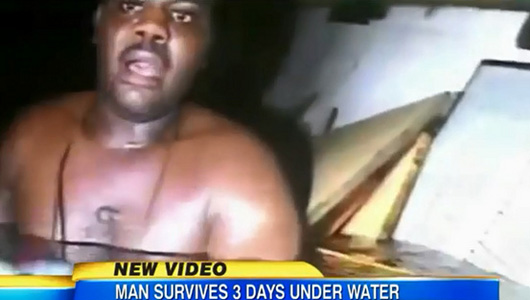Ever since the story broke of a man surviving underwater for three days, people have been asking how this was possible. The Nigerian man was lost at sea and assumed dead by everyone after his boat, the AHT Jascon-4, went underwater and sank down to more than a hundred feet blow the surface. The man’s name was Okene, and he had been a cook board the ship. When the vessel capsized, he was trapped in a tiny bathroom under the water and had no way to signal for anything – especially for help. However, he was in an air bubble so he was able to survive the three long days, although he had no food or water during that time. That meant that he was in a very weak state by the time that the divers found him.
 The video of the rescue went viral on YouTube. The video shows the man reaching his hand up as the divers approach, and you can see the air bubble that he was trapped in. This rescue was six months ago, and the divers had originally set off to recover the bodies of the downed boat. You hear someone on the video say “alive, alive” and then, you see his hand reaching out, desperate for help. The wonder wasn’t really that he had an air bubble that lasted that long, it was that he did not run undergo carbon dioxide toxicity. In the 4×4 side area that he was in, nearly 14 cubic meters, he had about 56 hours of air, according ot the Duke Center for Hyperbaric Medicine & Environmental Physiology.
The video of the rescue went viral on YouTube. The video shows the man reaching his hand up as the divers approach, and you can see the air bubble that he was trapped in. This rescue was six months ago, and the divers had originally set off to recover the bodies of the downed boat. You hear someone on the video say “alive, alive” and then, you see his hand reaching out, desperate for help. The wonder wasn’t really that he had an air bubble that lasted that long, it was that he did not run undergo carbon dioxide toxicity. In the 4×4 side area that he was in, nearly 14 cubic meters, he had about 56 hours of air, according ot the Duke Center for Hyperbaric Medicine & Environmental Physiology.
“If you’re trapped in something like that, your carbon dioxide levels will build to a toxic level before you use up the oxygen,” said Eric Hexdall, clinical director of diving at the Duke Center. That would have been his main problem, rather than the more common belief that he would run out of oxygen. There are apparently several stages of carbon dioxide toxicity, and symptoms would include a sort of buzz or a feeling of being high. Then, the person would lose consciousness. “It wouldn’t have necessarily poisoned him,” Hexdall said. “It would have taken about 79 hours for him to be unconscious from carbon dioxide.”








